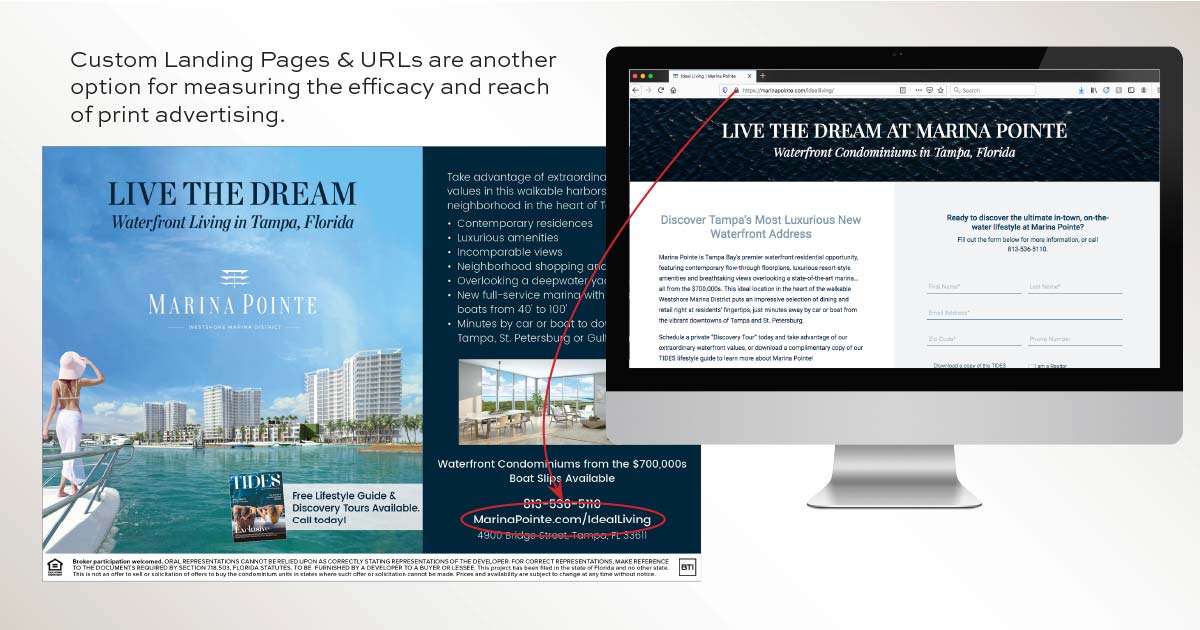06 Mar Advertising Metrics for Print Ads

Regardless of the clientele or customer base, every advertising and marketing campaign revolves around return on investment (ROI). However, in an increasingly digital world it can be tricky to prove and calculate ROI for traditional and print advertising efforts.
Print advertising remains an incredibly valuable tool for enhancing awareness and driving traffic, but what’s the best way to demonstrate that value throughout campaigns? What advertising metrics can you use to measure a print ad’s success?
Below are our recommendations for tracking ROI on print advertising:
![]()
Use Call Tracking Numbers to Measure Print ROI
One way to reveal the effectiveness of print advertising is to set up call or text tracking for every component of the campaign, including print ads, TV ads, digital ads, collateral and direct mail.
Unique call tracking systems like CallRail or Invoca allow your agency team to track and report on daily, weekly and monthly activity for print as well as digital initiatives. If a $4,000 luxury magazine ad didn’t generate any calls but a $200 local newspaper ad generated 17 calls, an agency can use that data to make informed recommendations for upcoming media placements and media spend.
With that said, it’s not enough to simply apply a special call tracking number to ads. If call tracking is going to form the foundation of your campaign’s print advertising KPIs, make sure the ad’s call-to-action (CTA) directs readers to the custom phone number and that the phone number stands out within the ad creative.

Calculate ROI via Custom Landing Pages & URLs
Custom landing pages and vanity URLs are another viable option for measuring the efficacy and reach of print advertising.
Prospective purchasers may not commit to picking up the phone and calling your sales gallery right after seeing an ad in the paper, but they’re likely to type in the URL and explore your website. Setting up a custom landing page for specific ad campaigns allows marketers to track online traffic in the backend, which reflects the ROI for the campaign or creative.
We recommend including a form fill on these custom landing pages that encourages site visitors to download a lifestyle guide or another piece of premium content. This allows developers to collect prospects’ information and successfully incorporate the lead into their database, and provide the prospect with an immediate “reward.”
If a print ad performs well, the team would see a spike in website activity and form fills for the page that could easily be tracked and measured via quantitative digital dashboards as well as customer management software such as Builder CMS.
![]()
Form Submissions
If you decide not to have a custom landing page or vanity URL created for tracking ROI on print advertising, you can still monitor traffic via website form submissions. Simply make “How did you hear about us?” a mandatory field on the form and include ‘print – newspaper/magazine’ as one of the first selections.
However, this may not provide the most accurate advertising metrics, as the form won’t be publication-specific and consumers may not accurately disclose how they first learned about a product.
Even the most successful advertising campaigns require multiple touchpoints before a consumer finally converts and makes a direct inquiry or in-person appearance. It is probable that a prospect saw multiple ad placements across print, digital and traditional media (like television, billboards or other signage) before filling out a form or walking in to a sales gallery.
That “last touch” attribution model could negatively skew the data showcasing print advertising’s success. Not to mention, a consumer may not remember the specific touchpoint that brought them through the door.
Let’s say a consumer read about the product in a magazine three months ago, ran an organic search last week for condos in the area, and ultimately filled out a form via a retargeting display ad. In this case, they may not put “print” as the primary source and may say “Internet” instead.
We Maximize Clients’ Return on Marketing Investment
United Landmark Associates is one of Tampa Bay’s leading marketing agencies, with 35 years of experience leading the way in luxury and real estate. Our talented team offers a comprehensive, data-based approach to marketing, providing clients with everything from detailed digital analytics to jaw-dropping traditional ad creative. Contact us at 813-870-9519 or fill out our contact form to find out how we can take your present or future campaigns to impressive new heights.


